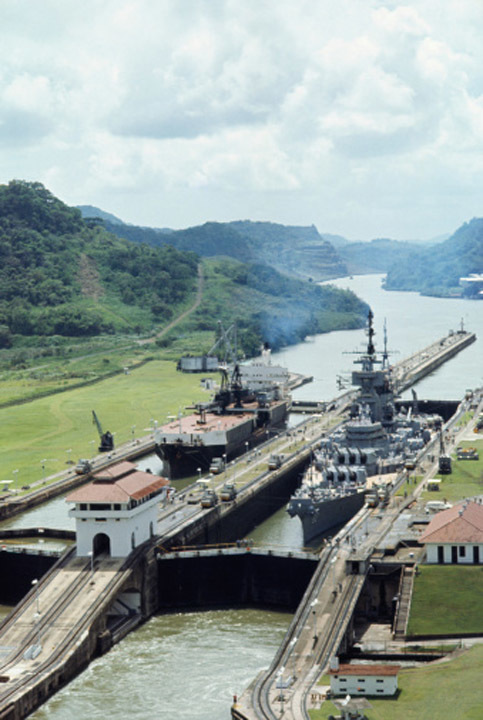“Far better it is to dare mighty things, to win glorious triumphs, even though checkered by failure than … to live in the gray twilight that knows not victory or defeat.” —Theodore Roosevelt
IXTAPA, MEXICO — Our history on earth tells us there isn’t an idea, invention, or project dreamed about that cannot someday become reality. It is part of mankind’s DNA to dream the improbable, even the impossible, and to eventually make it happen.
When Jules Verne wrote of submarines and traveling to the moon, it was science fiction but it gave spark to the possibility and inspired scientists, astronomers, and engineers that followed.
This all comes to mind as I currently travel with 1,300 other cruise ship passengers on our way to see one of the largest projects ever conceived and built. Its construction is a story of courage, deep tragedy, medical breakthroughs and engineering ingenuity.
It is the story of the building of the Panama Canal.
The idea of a passageway between the Atlantic and Pacific Oceans through the Americas dates back centuries when Columbus and others explored for trade routes to the East. When gold was discovered in California in 1849, the need for a faster transportation route for prospectors and supplies to the west coast soon became apparent.
In 1870, when the U. S. Secretary of the Navy appointed Commander Thomas Selfridge to lead an expedition to ascertain the point at which to cut a canal joining the two oceans, the project captured the imagination of the world.
In 1880, the French sponsored the first serious attempt to build the Panama Canal. Led by Ferdinand de Lesseps (who built the Suez Canal in 1869), the privately held company, Companie Universelle du Canal Interoceanique, began construction. By 1882, scores of engineers and thousands of laborers of all nationalities were at work and the first excavation and dredging began with the aid of 30 steam shovels, 50 locomotives, 3,000 flatcars and dirt trucks and over 80 miles of railroad track.
Immediately, the project ran into difficulty. The French engineers had no experience in the tropics and plagued by poisonous snakes, rains, earthquakes, and mechanical issues the project proceeded slowly. Even worse, the mortality rate of workers was horrendous due to the prevalence of malaria and yellow fever. By 1889, over twenty thousand workers had died and the company was bankrupt.
The monumental French failure — lasting more than a decade and spending an estimated $287 million — cost more than had been spent on any peaceful undertaking to date. It was clear the project was too big for a private enterprise — it needed to be a national venture.
This was a time in American history when anything was possible. U.S. Steel and the Ford Motor Company were in their infancy. In Alaska, Juneau’s Treadwell Mine, the world’s largest hard rock gold mine, was operating 960 stamp mills producing millions in gold each year.
In 1897, Teddy Roosevelt was appointed Assistant Secretary of the Navy. Greatly influenced by the expansionist spirit in America, he realized the strategic importance of the canal to America’s growth and progress.
Later, as President, Roosevelt encouraged and guided the negotiations leading to the U.S. securing title to the French properties and the signing of a treaty in 1903 allowing canal construction across Panama. The $50 million price paid to the French and Panama was more than the combined price for Alaska, the Philippines, and the Louisiana Purchase.
Although the French had managed to leave a 25 foot wide navigable canal 11 miles long, little else of value remained of their effort and the oceans were still almost 40 miles apart. The French buildings and equipment were unserviceable and in deplorable condition. The Americans were required to begin anew.
And so they did. Within a few short years, new hospitals, housing, mess halls, water and sewer systems, telephone lines, a rebuilt railroad, and hundreds of pieces of equipment were installed and canal construction re-commenced in earnest. Workers were recruited from over 97 countries. Average pay was $87 per month with free housing and medical care.
But the first order of business was to contain and minimize the rampant disease conditions. At the time, the idea malaria and yellow fever were transmitted by certain mosquitoes was just being introduced. An authority on tropical diseases, Dr. William Gorgas, was hired to devise the most costly and concentrated health campaign the world had ever seen. His methods, later modeled by other nations, eliminated yellow fever within 8 months and malaria shortly thereafter.
On the engineering front, it soon became apparent a sea level canal as envisioned by the French wasn’t technically feasible and plans were altered to allow for a lock canal. A dam was built, creating the 164 square mile Gatun Lake – the largest artificial lake in the world.
Many other challenges awaited the American effort.
In my next column, after our cruise ship transits the Panama Canal, I will discuss these challenges, how they were overcome, and how the lessons learned then have application today.
Win Gruening retired as the senior vice president in charge of business banking for Key Bank in 2012. He was born and raised in Juneau and is active in community affairs as a 30-plus year member of Juneau Downtown Rotary Club and has been involved in various local and statewide organizations.

